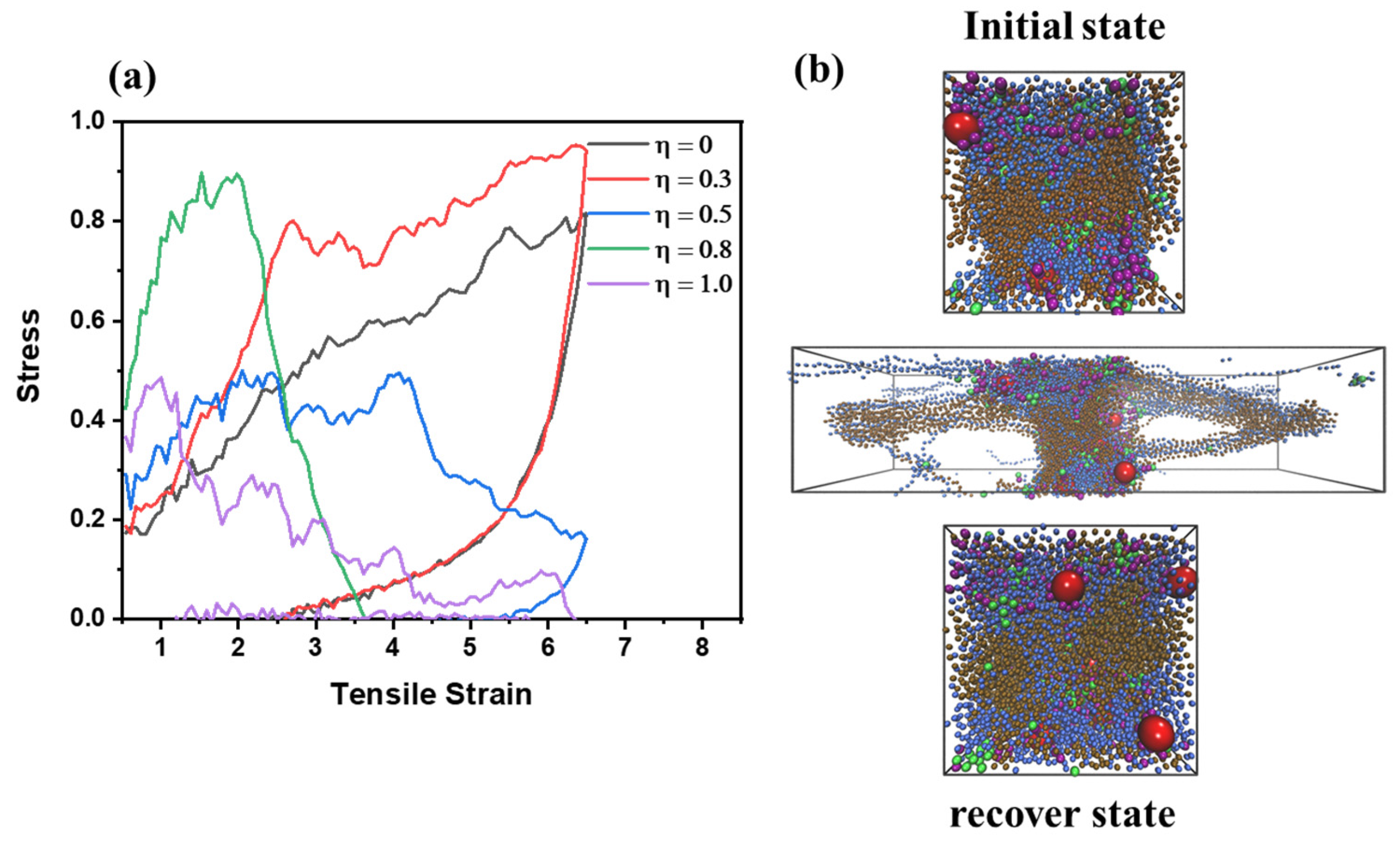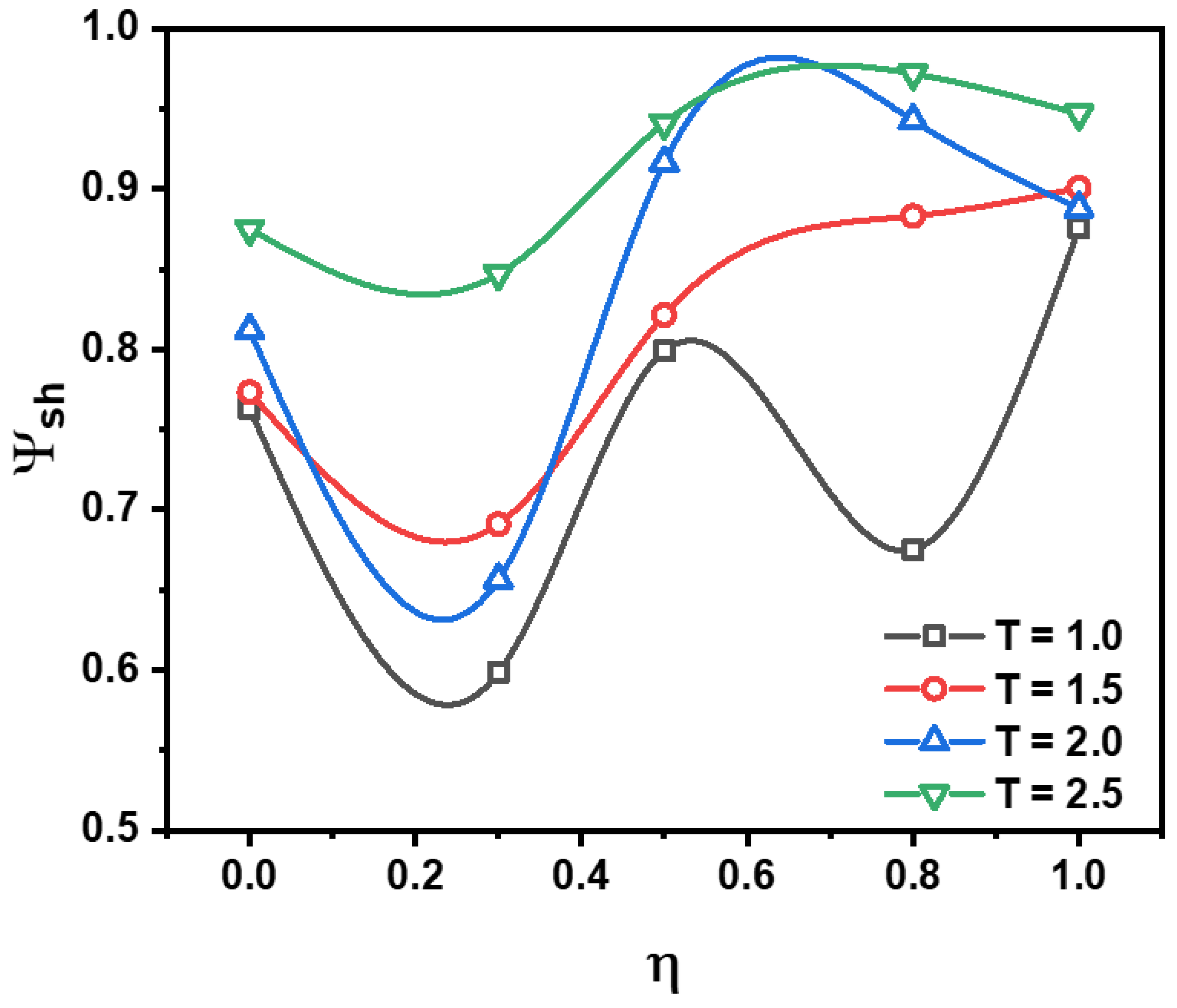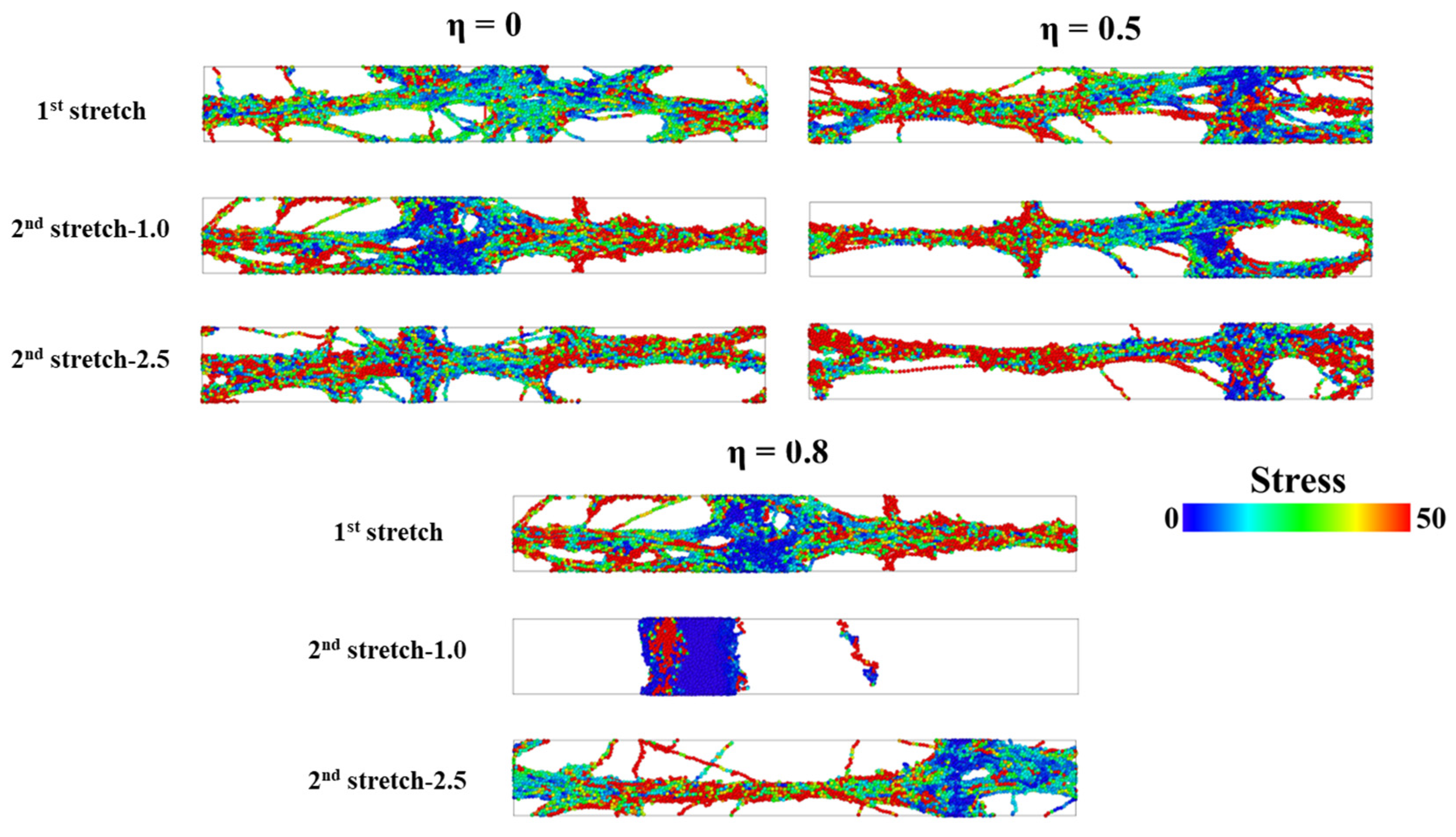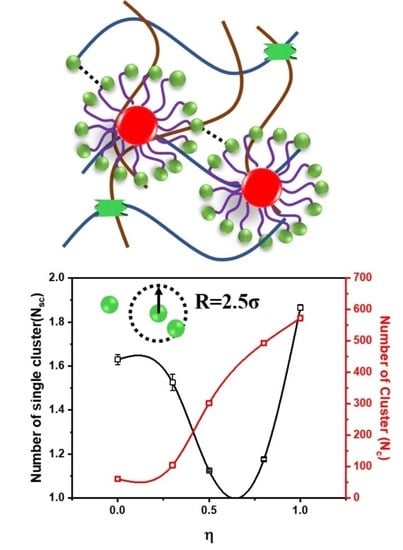Molecular Dynamics Simulation of Polymer Nanocomposites with Supramolecular Network Constructed via Functionalized Polymer End-Grafted Nanoparticles
Abstract
:1. Introduction
2. Simulation Methods
3. Results and Discussion
3.1. Effect of η on the Structure and Dynamics of PNCs
3.2. The Static Mechanical Performance and Self-Healing Behavior of PNCs
4. Conclusions
Supplementary Materials
Author Contributions
Funding
Institutional Review Board Statement
Data Availability Statement
Acknowledgments
Conflicts of Interest
References
- Kumar, S.K.; Benicewicz, B.C.; Vaia, R.A.; Winey, K.I. 50th Anniversary Perspective: Are Polymer Nanocomposites Practical for Applications? Macromolecules 2017, 50, 714–731. [Google Scholar] [CrossRef]
- Moretto, E.; Fernandes, J.P.C.; Staropoli, M.; Rogé, V.; Steiner, P.; Duez, B.; Lenoble, D.; Thomann, J.-S. Dual-Silane Premodified Silica Nanoparticles─Synthesis and Interplay between Chemical, Mechanical, and Curing Properties of Silica–Rubber Nanocomposites: Application to Tire Tread Compounds. ACS Omega 2022, 7, 17692–17702. [Google Scholar] [CrossRef]
- Ji, H.; Yang, H.; Zhou, X.; Sun, C.; Li, L.; Zhao, S.; Yu, J.; Li, S.; Wang, R.; Zhang, L. Preparation of bio-based elastomer and its nanocomposites based on dimethyl itaconate with versatile properties. Compos. Part B Eng. 2023, 248, 110383. [Google Scholar] [CrossRef]
- Jung, J.; Sodano, H.A. Cellulose nanocrystal functionalized aramid nanofiber reinforced rubber compounds for tire tread application. Cellulose 2022, 29, 7735–7749. [Google Scholar] [CrossRef]
- Saddique, A.; Lee, H.M.; Kim, J.C.; Bae, J.; Cheong, I.W. Cellulose nanocrystal nanocomposites capable of low-temperature and fast self-healing performance. Carbohydr. Polym. 2022, 296, 119973. [Google Scholar] [CrossRef]
- Chen, Y.; Zhao, X.; Luo, C.; Shao, Y.; Yang, M.-B.; Yin, B. A facile fabrication of shape memory polymer nanocomposites with fast light-response and self-healing performance. Compos. Part A Appl. Sci. Manuf. 2020, 135, 105931. [Google Scholar] [CrossRef]
- Chen, Y.; Zhao, X.; Li, Y.; Jin, Z.-Y.; Yang, Y.; Yang, M.-B.; Yin, B. Light- and magnetic-responsive synergy controlled reconfiguration of polymer nanocomposites with shape memory assisted self-healing performance for soft robotics. J. Mater. Chem. C 2021, 9, 5515–5527. [Google Scholar] [CrossRef]
- Dai, X.; Huang, L.-B.; Du, Y.; Han, J.; Kong, J. Self-healing flexible strain sensors based on dynamically cross-linked conductive nanocomposites. Compos. Commun. 2021, 24, 100654. [Google Scholar] [CrossRef]
- Lorwanishpaisarn, N.; Kasemsiri, P.; Jetsrisuparb, K.; Knijnenburg, J.T.N.; Hiziroglu, S.; Pongsa, U.; Chindaprasirt, P.; Uyama, H. Dual-responsive shape memory and self-healing ability of a novel copolymer from epoxy/cashew nut shell liquid and polycaprolactone. Polym. Test. 2020, 81, 106159. [Google Scholar] [CrossRef]
- Perera, M.M.; Ayres, N. Dynamic covalent bonds in self-healing, shape memory, and controllable stiffness hydrogels. Polym. Chem. 2020, 11, 1410–1423. [Google Scholar] [CrossRef]
- Liu, Y.; Tang, Z.; Wu, S.; Guo, B. Integrating Sacrificial Bonds into Dynamic Covalent Networks toward Mechanically Robust and Malleable Elastomers. ACS Macro Lett. 2019, 8, 193–199. [Google Scholar] [CrossRef]
- Palmeri, M.J.; Putz, K.W.; Brinson, L.C. Sacrificial Bonds in Stacked-Cup Carbon Nanofibers: Biomimetic Toughening Mechanisms for Composite Systems. ACS Nano 2010, 4, 4256–4264. [Google Scholar] [CrossRef]
- Huang, J.; Zhang, L.; Tang, Z.; Guo, B. Bioinspired engineering of sacrificial bonds into rubber networks towards high-performance and functional elastomers. Compos. Commun. 2018, 8, 65–73. [Google Scholar] [CrossRef]
- Jin, S.B.; Son, G.S.; Kim, Y.H.; Kim, C.G. Enhanced durability of silanized multi-walled carbon nanotube/epoxy nanocomposites under simulated low earth orbit space environment. Compos. Sci. Technol. 2013, 87, 224–231. [Google Scholar] [CrossRef]
- Zhang, Z.; Luo, J.; Zhao, S.; Ge, S.; Carrillo, J.-M.Y.; Keum, J.K.; Do, C.; Cheng, S.; Wang, Y.; Sokolov, A.P.; et al. Surpassing the stiffness-extensibility trade-off of elastomers via mastering the hydrogen-bonding clusters. Matter 2022, 5, 237–252. [Google Scholar] [CrossRef]
- Liu, M.; Li, S.; Fang, Y.; Chen, Z.; Alyas, M.; Liu, J.; Zeng, X.; Zhang, L. Mechanical and Self-Healing Behavior of Matrix-Free Polymer Nanocomposites Constructed via Grafted Graphene Nanosheets. Langmuir 2020, 36, 7427–7438. [Google Scholar] [CrossRef]
- Zhang, Z.; Liu, J.; Li, S.; Gao, K.; Ganesan, V.; Zhang, L. Constructing Sacrificial Multiple Networks To Toughen Elastomer. Macromolecules 2019, 52, 4154–4168. [Google Scholar] [CrossRef]
- Zhou, Y.; Hou, D.; Geng, G.; Feng, P.; Yu, J.; Jiang, J. Insights into the interfacial strengthening mechanisms of calcium-silicate-hydrate/polymer nanocomposites. Phys. Chem. Chem. Phys. 2018, 20, 8247–8266. [Google Scholar] [CrossRef]
- An, D.; Duan, X.; Cheng, S.; Zhang, Z.; Yang, B.; Lian, Q.; Li, J.; Sun, Z.; Liu, Y.; Wong, C.-P. Enhanced thermal conductivity of natural rubber based thermal interfacial materials by constructing covalent bonds and three-dimensional networks. Compos. Part A Appl. Sci. Manuf. 2020, 135, 105928. [Google Scholar] [CrossRef]
- Wang, Q.; Hou, R.; Cheng, Y.; Fu, J. Super-tough double-network hydrogels reinforced by covalently compositing with silica-nanoparticles. Soft Matter 2012, 8, 6048–6056. [Google Scholar] [CrossRef]
- Park, C.; Kim, G.; Jung, J.; Krishnakumar, B.; Rana, S.; Yun, G.J. Enhanced self-healing performance of graphene oxide/vitrimer nanocomposites: A molecular dynamics simulations study. Polymer 2020, 206, 122862. [Google Scholar] [CrossRef]
- Zhou, H.; Wang, H.; Niu, H.; Gestos, A.; Lin, T. Robust, Self-Healing Superamphiphobic Fabrics Prepared by Two-Step Coating of Fluoro-Containing Polymer, Fluoroalkyl Silane, and Modified Silica Nanoparticles. Adv. Funct. Mater. 2013, 23, 1664–1670. [Google Scholar] [CrossRef]
- Habib, S.; Hassanein, A.; Kahraman, R.; Mahdi Ahmed, E.; Shakoor, R.A. Self-healing behavior of epoxy-based double-layer nanocomposite coatings modified with Zirconia nanoparticles. Mater. Des. 2021, 207, 109839. [Google Scholar] [CrossRef]
- Imato, K.; Natterodt, J.C.; Sapkota, J.; Goseki, R.; Weder, C.; Takahara, A.; Otsuka, H. Dynamic covalent diarylbibenzofuranone-modified nanocellulose: Mechanochromic behaviour and application in self-healing polymer composites. Polym. Chem. 2017, 8, 2115–2122. [Google Scholar] [CrossRef]
- Guo, H.; Huang, S.; Xu, A.; Xue, W. Injectable Adhesive Self-Healing Multiple-Dynamic-Bond Crosslinked Hydrogel with Photothermal Antibacterial Activity for Infected Wound Healing. Chem. Mater. 2022, 34, 2655–2671. [Google Scholar] [CrossRef]
- Utrera-Barrios, S.; Verdugo Manzanares, R.; Araujo-Morera, J.; González, S.; Verdejo, R.; López-Manchado, M.Á.; Hernández Santana, M. Understanding the Molecular Dynamics of Dual Crosslinked Networks by Dielectric Spectroscopy. Polymers 2021, 13, 3234. [Google Scholar] [CrossRef]
- Li, C.; Strachan, A. Molecular scale simulations on thermoset polymers: A review. J. Polym. Sci. Part B Polym. Phys. 2015, 53, 103–122. [Google Scholar] [CrossRef]
- Wick, C.D.; Peters, A.J.; Li, G. Quantifying the contributions of energy storage in a thermoset shape memory polymer with high stress recovery: A molecular dynamics study. Polymer 2021, 213, 123319. [Google Scholar] [CrossRef]
- Fu, K.; Xie, Q.; LÜ, F.; Duan, Q.; Wang, X.; Zhu, Q.; Huang, Z. Molecular Dynamics Simulation and Experimental Studies on the Thermomechanical Properties of Epoxy Resin with Different Anhydride Curing Agents. Polymers 2019, 11, 975. [Google Scholar] [CrossRef] [Green Version]
- Stetsyshyn, Y.; Raczkowska, J.; Harhay, K.; Gajos, K.; Melnyk, Y.; Dąbczyński, P.; Shevtsova, T.; Budkowski, A. Temperature-responsive and multi-responsive grafted polymer brushes with transitions based on critical solution temperature: Synthesis, properties, and applications. Colloid Polym. Sci. 2021, 299, 363–383. [Google Scholar] [CrossRef]
- Zheng, Z.; Xia, X.; Zeng, X.; Li, X.; Wu, Y.; Liu, J.; Zhang, L. Theoretical Model of Time–Temperature Superposition Principle of the Self-Healing Kinetics of Supramolecular Polymer Nanocomposites. Macromol. Rapid Commun. 2018, 39, 1800382. [Google Scholar] [CrossRef] [PubMed]
- Chen, J.; Li, C.; Jia, H.; Shen, Z.; Zhao, R.; Su, T.; Xiang, B.; Wang, X.; Boukhvalov, D.W.; Luo, Z.; et al. Novel Molecular-Level Insight into the Self-Healing Behavior and Mechanism of Polyurethane-Urea Elastomer Based on a Noncovalent Strategy. Macromolecules 2022, 55, 4776–4789. [Google Scholar] [CrossRef]
- Hou, G.; Li, S.; Liu, J.; Weng, Y.; Zhang, L. Designing high performance polymer nanocomposites by incorporating robustness-controlled polymeric nanoparticles: Insights from molecular dynamics. Phys. Chem. Chem. Phys. 2022, 24, 2813–2825. [Google Scholar] [CrossRef]
- Smale, S. Mathematical problems for the next century. Math. Front. Perspect. 2000, 20, 271–294. [Google Scholar]
- Zhang, Z.; Hou, G.; Shen, J.; Liu, J.; Gao, Y.; Zhao, X.; Zhang, L. Designing the Slide-Ring Polymer Network with both Good Mechanical and Damping Properties via Molecular Dynamics Simulation. Polymers 2018, 10, 964. [Google Scholar] [CrossRef] [Green Version]
- Hou, G.; Tao, W.; Liu, J.; Gao, Y.; Zhang, L.; Li, Y. Tailoring the dispersion of nanoparticles and the mechanical behavior of polymer nanocomposites by designing the chain architecture. Phys. Chem. Chem. Phys. 2017, 19, 32024–32037. [Google Scholar] [CrossRef]
- Hou, G.; Xia, X.; Liu, J.; Wang, W.; Dong, M.; Zhang, L. Designing Superlattice Structure via Self-Assembly of One-Component Polymer-Grafted Nanoparticles. J. Phys. Chem. B 2019, 123, 2157–2168. [Google Scholar] [CrossRef]
- Sharma, A.; Mukhopadhyay, T.; Rangappa, S.M.; Siengchin, S.; Kushvaha, V. Advances in Computational Intelligence of Polymer Composite Materials: Machine Learning Assisted Modeling, Analysis and Design. Arch. Comput. Methods Eng. 2022, 29, 3341–3385. [Google Scholar] [CrossRef]
- He, J.; Chen, Q.; Qu, J.; Li, S.; Fu, Z.; Wei, Y.; Hu, S.; Feng, A.; Zhang, L.; Liu, J. Mechanically Robust and Self-Healing Elastomers Based on Dynamic Oxime–Carbamate Bonds: A Combined Experiment and All-Atom Simulation Study. ACS Appl. Polym. Mater. 2023, 5, 3161–3172. [Google Scholar] [CrossRef]
- Zhao, H.; Wei, X.; Fang, Y.; Gao, K.; Yue, T.; Zhang, L.; Ganesan, V.; Meng, F.; Liu, J. Molecular Dynamics Simulation of the Structural, Mechanical, and Reprocessing Properties of Vitrimers Based on a Dynamic Covalent Polymer Network. Macromolecules 2022, 55, 1091–1103. [Google Scholar] [CrossRef]
- Chen, R.; Zhang, Z.; Zhou, M.; Han, Y.; Li, F.; Liu, J.; Zhang, L. Molecular Dynamics Simulations of Polymer Nanocomposites Welding: Interfacial Structure, Dynamics and Strength. Macromol. Rapid Commun. 2022, 43, 2200221. [Google Scholar] [CrossRef]
- Zhang, Z.; Fang, Y.; Chen, Q.; Duan, P.; Wu, X.; Zhang, L.; Wu, W.; Liu, J. Molecular dynamics simulation of the impact of the surface topology of carbon black on the mechanical properties of elastomer nanocomposites. Phys. Chem. Chem. Phys. 2023, 25, 5602–5612. [Google Scholar] [CrossRef] [PubMed]
- Kröger, M. Shortest multiple disconnected path for the analysis of entanglements in two- and three-dimensional polymeric systems. Comput. Phys. Commun. 2005, 168, 209–232. [Google Scholar] [CrossRef]
- Shanbhag, S.; Kröger, M. Primitive Path Networks Generated by Annealing and Geometrical Methods: Insights into Differences. Macromolecules 2007, 40, 2897–2903. [Google Scholar] [CrossRef]
- Hoy, R.S.; Foteinopoulou, K.; Kröger, M. Topological analysis of polymeric melts: Chain-length effects and fast-converging estimators for entanglement length. Phys. Rev. E 2009, 80, 031803. [Google Scholar] [CrossRef] [PubMed] [Green Version]
- Karayiannis, N.C.; Kröger, M. Combined Molecular Algorithms for the Generation, Equilibration and Topological Analysis of Entangled Polymers: Methodology and Performance. Int. J. Mol. Sci. 2009, 10, 5054. [Google Scholar] [CrossRef] [Green Version]
- Moyassari, A.; Gkourmpis, T.; Hedenqvist, M.S.; Gedde, U.W. Molecular dynamics simulation of linear polyethylene blends: Effect of molar mass bimodality on topological characteristics and mechanical behavior. Polymer 2019, 161, 139–150. [Google Scholar] [CrossRef]









| Interaction Type | Interaction Parameter (ε) Value | Cutoff Distance rcutoff |
|---|---|---|
| Modified group-Modified group | 10.0 | 2.5 |
| NP-matrix (AA and BB) | 3.5 | 2.24 |
| NP-grafted beads | 1.0 | 1.12 |
| others | 1.0 | 2.5 |
| System | Lp | <Z> | |
|---|---|---|---|
| η = 0 | 12.158 | 17.384 | 2.950 |
| η = 0.3 | 89.174 | 11.098 | 17.404 |
| η = 0.5 | 95.435 | 11.339 | 20.276 |
| η = 0.8 | 103.783 | 14.404 | 33.281 |
| η = 1.0 | 120.478 | 14.82 | 41.101 |
Disclaimer/Publisher’s Note: The statements, opinions and data contained in all publications are solely those of the individual author(s) and contributor(s) and not of MDPI and/or the editor(s). MDPI and/or the editor(s) disclaim responsibility for any injury to people or property resulting from any ideas, methods, instructions or products referred to in the content. |
© 2023 by the authors. Licensee MDPI, Basel, Switzerland. This article is an open access article distributed under the terms and conditions of the Creative Commons Attribution (CC BY) license (https://creativecommons.org/licenses/by/4.0/).
Share and Cite
Hou, G.; Ren, R.; Shang, W.; Weng, Y.; Liu, J. Molecular Dynamics Simulation of Polymer Nanocomposites with Supramolecular Network Constructed via Functionalized Polymer End-Grafted Nanoparticles. Polymers 2023, 15, 3259. https://doi.org/10.3390/polym15153259
Hou G, Ren R, Shang W, Weng Y, Liu J. Molecular Dynamics Simulation of Polymer Nanocomposites with Supramolecular Network Constructed via Functionalized Polymer End-Grafted Nanoparticles. Polymers. 2023; 15(15):3259. https://doi.org/10.3390/polym15153259
Chicago/Turabian StyleHou, Guanyi, Runhan Ren, Wei Shang, Yunxuan Weng, and Jun Liu. 2023. "Molecular Dynamics Simulation of Polymer Nanocomposites with Supramolecular Network Constructed via Functionalized Polymer End-Grafted Nanoparticles" Polymers 15, no. 15: 3259. https://doi.org/10.3390/polym15153259






